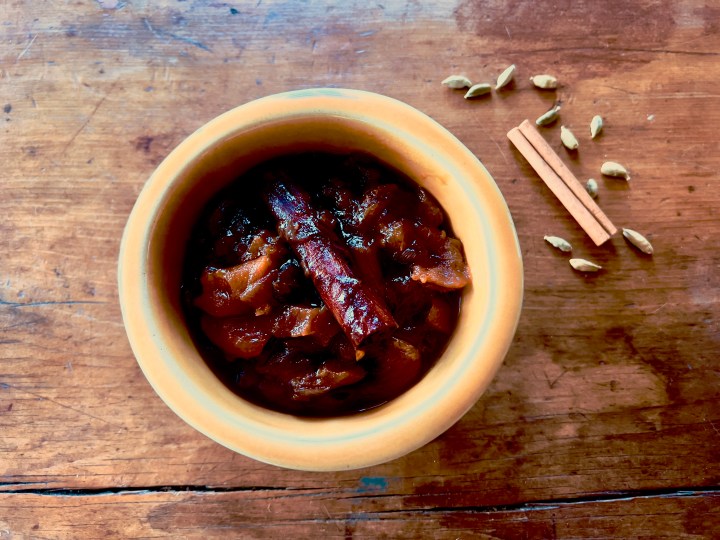DIY CHUTNEY
Throwback Thursday: Homemade peach and apricot chutney

Once upon a time, there was no commercial chutney sold in neatly labelled bottles. Instead, people made their own. It’s not difficult at all. Here’s my recipe for chutney made with Cape dried fruit.
In the 20th century, everything that could be tinned or bottled started going into cans and bottles. But in the 19th century and before, things were different. Even C Louis Leipoldt, who wrote in the early decades of the 20th century, remarked that, “Chutneys are sour-sweet, hot-sweet, or simply sweet concoctions of fruits or vegetables with spices and vinegar; their sweetness depends on the amount of sugar (formerly honey) that was added to them; their fieriness they owe to the pepper and chillies that go into them. Formerly they were all made at home; now they are usually bought ready-made by mass production, and are far from being what they ought to be.”
Think about that: Leipoldt is really saying that even our beloved Mrs HS Ball’s finest chutney is not going to make the cut as compared with the old chutneys that every home kitchen used to produce.
Leipoldt advises us that a good chutney should be “essentially a preserve, in which the consistency of the main ingredient, that gives a name to it, should be maintained and something of its original form should remain”. This after pointing out that there are very many kinds of chutney, from mango, pineapple and cucumber to melon, apple, peach, plum and quince, his own favourite.
So how to make one yourself? My advice to us today is to use the dried fruits that are now so ubiquitously available with even entire specialist shops devoted to them. You dice them to any size you like, which means that the smaller or bigger you cut them, that’s how chunky or smooth the resulting chutney is going to be.
I went with a medium size cube which gave me a fairly chunky chutney. But if you want yours to be smoother, just cut them as small as you like. As Liepoldt says, however, they must be clearly evident in the chutney once made, so I wouldn’t cut them so fine that there is scant texture at all to your chutney. They must, as he says, “be evident”.
You need onions, of course, though I wouldn’t use too many. You can make a great quantity of chutney or just a couple of jars. This quantity made about 3 conventional jam jars of chutney and only 1 large white onion was used. I used whole spices (cinnamon and cardamom) which can be removed before bottling. To avoid losing track of the cardamom pods, wrap them tightly in a little muslin sack, then discard that afterwards.
You can feel free to adapt my basic recipe. Add dates, dried apple or mango or both, etcetera. Add chillies, with or without their seeds; extra garlic and ginger, more sugar or less, and swap out the treacle sugar for brown or white sugar, or caramel or demerara sugar for that matter, as you prefer. Just have in mind the flavour and texture you want, and adapt accordingly.
Does my chutney emulate the famous commercial brand? I don’t pretend it does, exactly, nor did I set out to do that, though it does have something of the look and texture of it.
My resulting chutney was chunky; it’s clear that for a more smoothly textured one, all I’d need to do is dice the dried fruit smaller.
(Makes 3 jam jars)
Ingredients
1 large white onion, finely chopped
1 Tbsp coconut oil
2 fat garlic cloves, peeled and chopped finely
3 cm ginger, peeled and grated
250 g dried apricots, chopped
250 d dried peeled peaches, chopped
1 cinnamon stick
8 cardamom pods
1 tsp chilli powder
250 ml 1 cup treacle sugar
250 ml apple cider vinegar
Water to cover
Salt
Method
Heat the coconut oil in a heavy pot and add the chopped onion, then the garlic and ginger. Simmer gently just until softened, stirring.
Add the chopped fruit, sugar, vinegar, spices, salt lightly, and add water to cover plus 500 ml more water. This is going to reduce away during the cooking. What you’re looking for is a jammy texture similar to chutney as you know it from the Mrs HS Ball’s jar. That’s your objective.
Simmer, covered, on a low heat for about 2 hours or until you have that perfect sticky condiment. Make sure it does not catch at the bottom of the pot. Cool, remove the hard spices, then bottle in sterilised jars, right to the brim. DM
Follow Tony Jackman on Instagram @tony_jackman_cooks.
This dish is photographed in a bowl by Mervyn Gers Ceramics.





What a brilliant idea. Going to try it tomorrow!